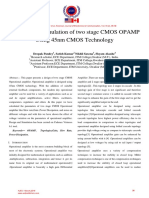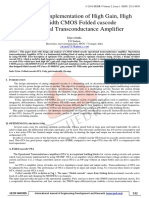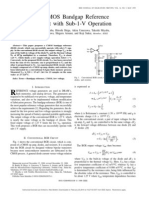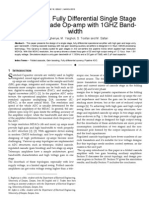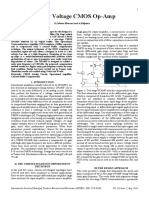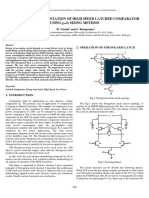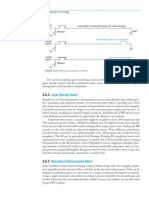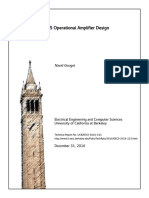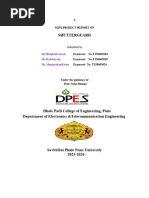Design of Two-Stage Operational Amplifier: Shahin Shah (12116053), Abhinav Singhal (12116001)
Uploaded by
Shahin ShahDesign of Two-Stage Operational Amplifier: Shahin Shah (12116053), Abhinav Singhal (12116001)
Uploaded by
Shahin ShahDesign of Two-Stage Operational Amplifier
Shahin Shah (12116053), Abhinav Singhal(12116001)
Indian Institute of Technology, Roorkee
AbstractThis paper presents a design of Two Stage CMOS
operational amplifier, which operates at 1.8V power supply
using umc 2m CMOS technology. The OP-AMP designed is a
two-stage CMOS OP-AMP. Design and Simulation has been
carried out in Cadence.
Formula used:
Index Terms 2 stage CMOS op-amp, design, simulation and
results.
I. INTRODUCTION
The designing of high performance analog integrated
circuits is becoming most essential with the continuous trend
towards the reduced supply voltages and transistor channel
length. MOS is most success among all because it can be
scaled down to smaller dimensions for higher performance.
The size can be reduced to micrometer or nanometer for getting
higher performance. On scaling down the Transistor size the
most important advantage is we can integrate more number of
transistor on the same size and we can get a faster amplifier
compared to previous one. This leads to continuous growth of
the processing capacity per chip and operating frequency.
In most of the electronics circuits the Operational
Amplifiers is the most common building blocks. So as the
transistor channel length and power supply is reduced then the
design of Op amps face continuous challenge. Due to different
aspect ratio (W/L), there is a tradeoff among speed, gain,
power and the other parameters. The purpose of the design
methodology in this paper is to propose accurate equations for
the design of high- gain 2 staged CMOS op-amp. For this, a
simple analysis with some meaningful parameters (such as gain
bandwidth, phase margin, etc.) is performed.
II. TWO STAGE OP-AMP DESIGN PROCEDURE
The first aspect considered in the design was to meet the
desired specifications. Based on a clear understanding of the
specifications, we have chosen the standard CMOS op-amp
circuit topology in our design.
TABLE I. Specification of two-stage CMOS op-amp
Specification Names
Values
Supply VDD
1.8V
Gain
>65 dB
Slew Rate
0.1 V/ns
CMRR
80 dB
Gain Bandwidth Product
60 MHz
Phase Margin
60o
Positive ICMR:
Negative ICMR:
60o phase margin requires that gm6 = 2.2gm2 (CL/Cc)
if all the roots are 10GB
gm1= gm2= gmI, gm6= gmII
DESIGN CHALLENGES AND TRADE-OFFS
Write your design challenges and trade-offs here.
III. SIMULATION RESULTS
All simulation results, figure and tables and discussion will
be here. Every figure and table should have discussion.
Figure 1. Schematic
Figure 2. Differential Mode Gain v/s Frequency
Figure 3. Differential Mode Gain v/s Phase
Figure 5. Common Mode Gain v/s Phase
FIGURE 4. COMMON MODE GAIN V/S FREQUENCY
Fig. 1. Example of a figure caption. (figure caption)
IV. CONCLUSIONS
This paper presented the full design and analysis of a two
stage CMOS Op-Amp.
REFERENCES
[1] B. Razavi, Design of Analog CMOS Integrated Circuits, New
York: Mc-Graw Hill,2001.
You might also like
- Two-Stage Operational Amplifier Design Using Gm/Id MethodNo ratings yetTwo-Stage Operational Amplifier Design Using Gm/Id Method7 pages
- Design High Speed, Low Noise, Low Power Two Stage CMOSNo ratings yetDesign High Speed, Low Noise, Low Power Two Stage CMOS5 pages
- Design of A Single Ended Two Stage Opamp Using 90Nm Cmos GPDK Technology100% (1)Design of A Single Ended Two Stage Opamp Using 90Nm Cmos GPDK Technology8 pages
- EE 06 Correlation Problems Part III v1 9-1-160% (1)EE 06 Correlation Problems Part III v1 9-1-164 pages
- A 4.596 GHZ, High Slew Rate, Ultra Low PowerNo ratings yetA 4.596 GHZ, High Slew Rate, Ultra Low Power6 pages
- Design of Two Stage Compensated Cmos Opamp-1No ratings yetDesign of Two Stage Compensated Cmos Opamp-13 pages
- Design and Implementation of High Gain, High Bandwidth CMOS Folded Cascode Operational Transconductance AmplifierNo ratings yetDesign and Implementation of High Gain, High Bandwidth CMOS Folded Cascode Operational Transconductance Amplifier5 pages
- Design of 12-Bit DAC Using CMOS TechnologyNo ratings yetDesign of 12-Bit DAC Using CMOS Technology5 pages
- A 180 NM Low Power CMOS Operational Amplifier: Ketan J. Raut R. Kshirsagar A. BhagaliNo ratings yetA 180 NM Low Power CMOS Operational Amplifier: Ketan J. Raut R. Kshirsagar A. Bhagali4 pages
- Performance Analysis of A Low-Power High-Speed Hybrid 1-Bit Full Adder Circuit Using Cmos Technologies Using Cadance100% (1)Performance Analysis of A Low-Power High-Speed Hybrid 1-Bit Full Adder Circuit Using Cmos Technologies Using Cadance8 pages
- Low Power Optimization of Full Adder Circuit Based On Gdi Logic For Biomedical ApplicationsNo ratings yetLow Power Optimization of Full Adder Circuit Based On Gdi Logic For Biomedical Applications11 pages
- Basics of Clock and Data Recovery Circuits Exploring High-Speed Serial LinksNo ratings yetBasics of Clock and Data Recovery Circuits Exploring High-Speed Serial Links14 pages
- C3.0 Operational Amplifiers II: Jeng-Han TsaiNo ratings yetC3.0 Operational Amplifiers II: Jeng-Han Tsai12 pages
- A High Gain, Fully Differential Single Stage Folded Cascade Op-Amp With 1GHZ Bandwidth0% (1)A High Gain, Fully Differential Single Stage Folded Cascade Op-Amp With 1GHZ Bandwidth5 pages
- 8-Bit R-2R Ladder Digital To Analog Converter With Equal CurrentsNo ratings yet8-Bit R-2R Ladder Digital To Analog Converter With Equal Currents17 pages
- Recommendations For Port Setup When Using ADS Momentum and Modelithics ModelsNo ratings yetRecommendations For Port Setup When Using ADS Momentum and Modelithics Models7 pages
- Principles of Semiconductor Devices: Chapter 7: MOS Field Effect TransistorsNo ratings yetPrinciples of Semiconductor Devices: Chapter 7: MOS Field Effect Transistors3 pages
- A Basic Introduction To The GM ID-Based Design PDF100% (4)A Basic Introduction To The GM ID-Based Design PDF15 pages
- Low Power High Speed Cmos Comparator DesignNo ratings yetLow Power High Speed Cmos Comparator Design5 pages
- Overview of 3D Architecture Design Opportunities and TechniquesNo ratings yetOverview of 3D Architecture Design Opportunities and Techniques6 pages
- Design and Analysis of Low Power Bandgap Voltage ReferenceNo ratings yetDesign and Analysis of Low Power Bandgap Voltage Reference8 pages
- Fully-Differential High-Speed and High-Precision Operational Amplifier DesignsNo ratings yetFully-Differential High-Speed and High-Precision Operational Amplifier Designs9 pages
- Microstrip and CPW Power Divider Design: Keysight Eesof EdaNo ratings yetMicrostrip and CPW Power Divider Design: Keysight Eesof Eda16 pages
- (Report) Design of A Low-Power Asynchronous SAR ADC in 45 NM CMOS TechnologyNo ratings yet(Report) Design of A Low-Power Asynchronous SAR ADC in 45 NM CMOS Technology50 pages
- Layer Density Rules: Chapter 3 CMOS Processing Technology100% (1)Layer Density Rules: Chapter 3 CMOS Processing Technology1 page
- Design of Sense Amplifier For Coupling Suppression by Using100% (1)Design of Sense Amplifier For Coupling Suppression by Using28 pages
- Eetop - CN - iSSCC 2022 T1 Analog in BCD TutorialNo ratings yetEetop - CN - iSSCC 2022 T1 Analog in BCD Tutorial169 pages
- Case 2: X Is A Knave So He Is Lying Y Is A Spy Z Has To Be A Knight But There Is Logical Inconsistency Case 2 Is Not PossibleNo ratings yetCase 2: X Is A Knave So He Is Lying Y Is A Spy Z Has To Be A Knight But There Is Logical Inconsistency Case 2 Is Not Possible1 page
- C: "B Is Always True." - D: "B Is A Liar, But He Didn't Rob The Bank" (1) D (2) B or C (3) B or D (4) C or DNo ratings yetC: "B Is Always True." - D: "B Is A Liar, But He Didn't Rob The Bank" (1) D (2) B or C (3) B or D (4) C or D1 page
- Directions: Each Question Consists of Five Statements Followed by OptionsNo ratings yetDirections: Each Question Consists of Five Statements Followed by Options1 page
- Q3. Four Jokers - A, B, C and D - Are Brought Before Batman. He Knows That Two of Them Are Lairs. - A: "D Robbed The Bank" - B: "C Is Always True."No ratings yetQ3. Four Jokers - A, B, C and D - Are Brought Before Batman. He Knows That Two of Them Are Lairs. - A: "D Robbed The Bank" - B: "C Is Always True."1 page
- Jyothishmathi Institute of Technology & Science: Unit V ARM Cortex-M3 ProcessorNo ratings yetJyothishmathi Institute of Technology & Science: Unit V ARM Cortex-M3 Processor4 pages
- Lists Vii: 2.9 2.10 Practical Considerations 50No ratings yetLists Vii: 2.9 2.10 Practical Considerations 504 pages
- Operator & Installation Manual Tr-810 857645No ratings yetOperator & Installation Manual Tr-810 85764550 pages
- Chapter 6 8086 Hardware Specifications PDFNo ratings yetChapter 6 8086 Hardware Specifications PDF42 pages
- Mathematical Modelling of Sampling ProcessNo ratings yetMathematical Modelling of Sampling Process6 pages
- Reviving Erroneous Stability-Based Clock-Gating Using Partial Max-SATNo ratings yetReviving Erroneous Stability-Based Clock-Gating Using Partial Max-SAT6 pages
- Quickspecs: HP Compaq La2205Wg 22-Inch Widescreen LCD MonitorNo ratings yetQuickspecs: HP Compaq La2205Wg 22-Inch Widescreen LCD Monitor8 pages
- Changjiang Electronics Tech CJ BCX56 - C24280No ratings yetChangjiang Electronics Tech CJ BCX56 - C242803 pages
- Micro-Programmed Versus Hardwired Control Units The Control UnitNo ratings yetMicro-Programmed Versus Hardwired Control Units The Control Unit11 pages
- Figure 3-1 Basic ROM Structure: Decoder Memory Array 2n Words X M Bits N Input LinesNo ratings yetFigure 3-1 Basic ROM Structure: Decoder Memory Array 2n Words X M Bits N Input Lines35 pages









